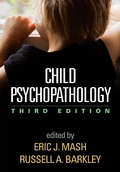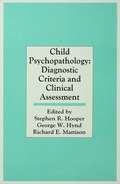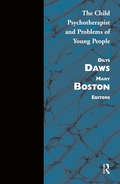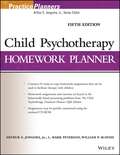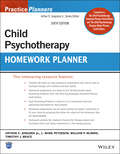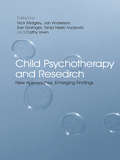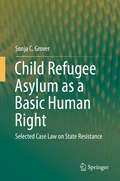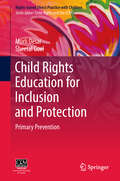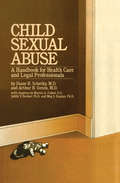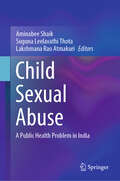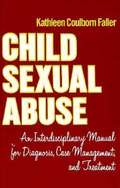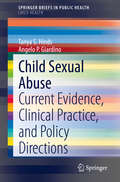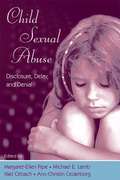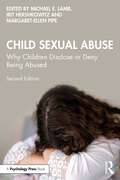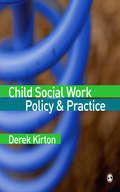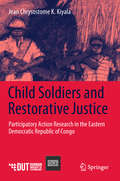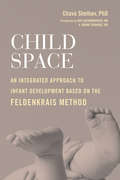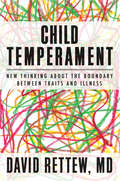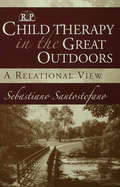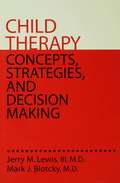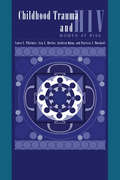- Table View
- List View
Child Psychopathology
by David A. Wolfe Eric J. Mash Katherine T. Nguyen WilliamsMash/Wolfe/Nguyen Williams' CHILD PSYCHOPATHOLOGY, 8th Edition, introduces you to childhood and adolescent disorders, treatments and preventions with an approach that recognizes the interconnectedness of biological, psychological, social and emotional influences. You'll learn about each disorder from the perspective of the whole child, with diagnostic criteria and an emphasis on the individual's strengths, environmental circumstances, issues regarding younger and older age groups and the risk and protective factors affecting developmental pathways. Case histories, examples and first-person accounts are at the heart of the text, bringing to life theories and disorders and the real people affected by them.
Child Psychopathology
by Eric J. Mash and Russell A. BarkleyThis highly respected reference and text on developmental psychopathology brings together leading authorities on the psychological, biological, and social-contextual determinants of child and adolescent problems. The comprehensive introductory chapter provides a state-of-the-art developmental--systems framework for understanding behavioral and emotional disturbances. Subsequent chapters synthesize the developmental bases of specific disorders. The characteristics, epidemiology, developmental course and outcomes, and etiological pathways of each disorder are described, as are risk and protective factors and issues in conceptualization and diagnosis. Important unanswered questions are identified and implications for treatment and prevention considered. New to This Edition *Includes DSM-5 criteria and discussion of changes. *Incorporates over a decade's worth of research advances in genetics, neurobiology, and other areas. *Chapters on bipolar disorder, suicide/self-injury, obsessive-compulsive spectrum disorders, and personality disorders.
Child Psychopathology: Diagnostic Criteria and Clinical Assessment
by Stephen R. Hooper George W. Hynd Richard E. MattisonThese two companion volumes provide a comprehensive review and critical evaluation of the major DSM-III and DSM-III-R child disorders. Their major goal is to provide diagnostic and assessment guidelines that are based on scientific literature in specific clinical domains. Each chapter contains a discussion of the historical background of a particular diagnosis, definitional issues, a critical but selective review of the literature addressing the diagnosis in question, proposed changes in the diagnostic criteria based on the available literature, and proposed assessment models and methods based on the designated criteria. Given the scientific bases for many of these discussions of diagnostic criteria, these two volumes will serve professionals and graduate students in a wide variety of fields: clinical child psychology, child psychiatry, pediatrics, pediatric and school psychology, special education, social work, and other child mental health specialties.
Child Psychotherapist and Problems of Young People
by Dilys Daws Mary BostonMany parents at some time dread that a child of theirs may be mentally ill or disturbed. But even after a generation of child psychology, psychiatry and psychotherapy, they still frequently fear to admit their fears, and fear the mystery of the remedy as much as the mystery of the problem. It is therefore important that parents should come to easy terms with the work of the psychotherapist, and be reassured that it is based on sympathetic understanding, not mysteries. It was to explain themselves to parents and others who work with other young people that sixteen psychotherapists and analysts (mostly following the principles of Anna Freud or Melanie Klein and largely drawn from the Hampstead Child Therapy and the Tavistock clinics in London) decided to collaborate in the preparation of this book. In it they set out to describe their work in schools, hospitals, clinics, day centres, etc and to discuss their fundamental approach to the treatment of the disturbed child.
Child Psychotherapy Homework Planner
by L. Mark Peterson Arthur E. Jongsma Jr. William P. Mcinnising format--allowing you to customize them to suit your and your clients' unique styles and needs
Child Psychotherapy Homework Planner (PracticePlanners)
by Arthur E. Jongsma L. Mark Peterson Timothy J. Bruce William P. McInnisBeneficial take-home assignments for young psychotherapy clients and their parents The Child Psychotherapy Homework Planner, Sixth Edition provides ready-to-use, between-session assignments designed to fit most therapeutic modes. Organized by presenting problem, this homework planner covers 36 issues, including anxiety, depression, adoption, academic underachievement, ADHD, low self-esteem, and PTSD. In this new edition, the homework assignments have been modified to be more accessible to children. Assignment sheets can be easily photocopied, and they are also available online to download and print—making client-specific modification simple. This easy-to-use sourcebook features: Nearly 100 ready-to-copy exercises covering the most common issues encountered by children A format that’s easy to navigate, including cross-references to alternate assignments that are relevant across multiple presentations Expert guidance on how and when to make the most efficient use of the exercises Clearly referenced correspondence with the The Child Psychotherapy Treatment Planner for a complete treatment approachThe Child Psychotherapy Homework Planner is a high-quality resource that practitioners can use to improve care and accountability. This is a valuable planner that will save therapists time on office work so they can focus on patients.
Child Psychotherapy and Research: New Approaches, Emerging Findings
by Jan Anderson Nick Midgley Cathy Urwin Eve Grainger Tanja Nesic-VuckovicChild Psychotherapy and Research brings together some of the most exciting and innovative research activity taking place within psychoanalytic child psychotherapy today. Drawing on the expertise of an international range of contributors, this book describes work at the cutting edge of research in psychoanalytic child psychotherapy and related areas. It presents many of the emerging findings while also illustrating a whole range of methodologies – both quantitative and qualitative – that have been developed to investigate this field. The book examines the historical and philosophical background of child psychotherapy research and shows how research illuminates different clinical phenomena, the processes of psychotherapy, its evaluation and outcome. Recent developments in therapeutic work with children, including the increased focus on evidence-based practice, make research a much higher priority in the field than ever before. With this increasing significance, a whole new generation of clinicians are required to become familiar and competent with research methods and research literature. Child Psychotherapy and Research will be a vital resource for anyone involved in research and training related to psychotherapy and child mental health, as well as of great interest to a range of mental health professionals.
Child Refugee Asylum as a Basic Human Right: Selected Case Law On State Resistance
by Sonja C. GroverThis book addresses the intersection of various domains of international law (refugee law, human rights law including child rights international law and humanitarian law) in terms of the implications for State obligations to child refugee asylum seekers in particular; both as collectives and as individual persons. How these State obligations have been interpreted and translated into practice in different jurisdictions is explored through selected problematic significant cases. Further, various threats to refugee children realizing their asylum rights, including refoulement of these children through State extraterritorial and pushback migration control strategies, are highlighted through selected case law. The argument is made that child refugee asylum seekers must not be considered, in theory or in practice, beyond the protection of the law if the international rule of law grounded on respect for human dignity and human rights is in fact to prevail.
Child Rights Education for Inclusion and Protection: Primary Prevention (Rights-based Direct Practice with Children)
by Murli Desai Sheetal GoelThe aims of child rights education are to make children and their primary duty-bearers aware of child rights so that they both can be empowered to together advocate for and apply them at their family, school and community levels. This sourcebook focuses on child rights education for primary prevention related to inclusion and protection. Child rights education for exclusion, non-discrimination and inclusion is discussed in the context of family and society with reference to girls, children with disability, and Dalit and tribal children, and child rights to cultural and financial inclusion. Child rights education for protection comprises prevention of violence against children with reference to physical abuse/ corporal punishment and bullying, commercial exploitation of children with reference to child labour and trafficking and sale of children, sexual abuse and exploitation of children, problems in adolescent sexual relationships such as violence, teenage pregnancy, abortion and unwed motherhood, and sexually transmitted infections and HIV, child marriage, and conflict with law. This is a necessary read for social workers, lawyers, researchers, trainers and teachers working on child rights across the world, and especially in developing countries.
Child Rights Education for Participation and Development: Primary Prevention (Rights-based Direct Practice with Children)
by Murli Desai Sheetal GoelThe aims of child rights education are to make children and their primary duty-bearers aware of child rights so that they both can be empowered to together advocate for and apply them at their family, school and community levels. This sourcebook focuses on child rights education for primary prevention with reference to participation and development. The introductory chapter covers child rights values of peace, dignity, tolerance, freedom, equality and justice and child rights principles of dignity of the child, primary consideration to the best interests of the child, universality and non-discrimination, and state and societal accountability. Child rights to participation focuses on child rights for playing a decisive and responsible role in their own life and a participatory role in the family, schools, associations, community and with the state as citizens. Child rights to development includes child rights to free, compulsory, comprehensive and quality education, free of discrimination and violence; child rights to play, recreational, cultural, and artistic activities and media literacy; child rights to health with reference to physical health and hygiene, healthy and hygienic food and nutrition, sexual health and prevention of substance abuse; and child rights to environmental education with reference to child rights to environmental harmony and hygiene and child rights to sustainable environment. This is a must-read for researchers, trainers, and other professionals working on child rights issues across the world, and especially in developing countries.
Child Sexual Abuse: A Handbook For Health Care And Legal Professions
by Diane H. Schetky Arthur H. GreenFirst published in 1988. Routledge is an imprint of Taylor & Francis, an informa company.
Child Sexual Abuse: A Public Health Problem in India
by Aminabee Shaik Suguna Leelavathi Thota Lakshmana Rao AtmakuriThis book is about child sexual abuse in India. Child sexual abuse (CSA) is a serious and wide-spread problem in India as it is in many parts of the world today. The trauma associated with sexual abuse can contribute to arrested development, as well as a host of psychological and emotional disorders, that some children and adolescents may never overcome. This edited book discusses the nature and incidence of the sexual abuse of minors in India and presents an overview of research findings to date. Socio-cultural and familial risk factors involved in CSA are discussed. Common symptoms and disorders associated with sexual abuse are outlined. The book also provides guidance on child protective services, coordinated response in preventing child abuse, mental health, and law enforcement. Finally, it discusses cognitive behavioral interventions to overcome the trauma caused due to sexual abuse.
Child Sexual Abuse: An Interdisciplinary Manual for Diagnosis, Case Management, and Treatment
by Kathleen Coulborn FallerThis book provides important and needed information to professionals who are likely to be confronted with child sexual abuse. It addresses an interdisciplinary audience that also includes doctors and nurses, law enforcement personnel, attorneys, and child welfare and court staff. The material in this book regarding assessment can greatly assist protective services workers, medical staff, and attorneys, as well as mental health professionals, in investigation techniques.
Child Sexual Abuse: Current Evidence, Clinical Practice, and Policy Directions (SpringerBriefs in Public Health)
by Angelo P. Giardino Tanya S. HindsThis brief approaches the challenging topic of child sexual abuse from an objective, evidence-based perspective. It offers an overview of child sexual abuse, including definitions and a clear explanation of the epidemiology. The text also explores the conceptual frameworks that seek to explain how a child comes to be sexually abused by an adult or older adolescent. In the chapters, the authors present credible prevalence and incidence studies that are used to provide a scientific response to how common this problem is. In addition, they address the policy implications for a myriad of prevention and treatment initiatives as well as related issues such as delayed reporting and the risk for sexual abuse within child serving organizations. Finally, the brief concludes with the authors' recommendations for the future on how best to prevent child sexual abuse in the first place. Prevention of child sexual abuse is very different than prevention of child physical abuse and neglect and requires a different framework and set of initiatives. Child Sexual Abuse: Current Evidence, Clinical Practice, and Policy Directions is a must-have resource for a range of professionals including healthcare providers, child advocates, clinical social workers, public health officials, mental health providers, and legislative staff professionals. It also is written in a readable manner for members of the lay public.
Child Sexual Abuse: Disclosure, Delay, and Denial
by Margaret-Ellen PipeThis volume provides the first rigorous assessment of the research relating to the disclosure of childhood sexual abuse, along with the practical and policy implications of the findings. Leading researchers and practitioners from diverse and international backgrounds offer critical commentary on these previously unpublished findings gathered from b
Child Sexual Abuse: Why Children Disclose or Deny Being Abused
by Michael E. Lamb Irit Hershkowitz Margaret-Ellen PipeThis fully revised volume provides a rigorous assessment of the latest research relating to the disclosure of childhood sexual abuse, along with the practical and policy implications of the findings.Leading researchers and practitioners from diverse and international backgrounds offer critical commentary on these findings gathered from both field and laboratory research. Building on the first edition, this book presents the research from the past twenty years on why delayed disclosure or denial is so common and what we can do about it. Chapters focus on field research interviewing reluctant children, including suspected victims of sexual abuse and other crimes, victims of trafficking, as well as young, suspected perpetrators of sexual abuse. Adding emphasis on research‑based methods for overcoming reluctance, it also explores the different dynamics and circumstances which affect disclosure patterns and the ways in which interviewers can facilitate disclosures.Child Sexual Abuse is for researchers and practitioners from child, forensic, and clinical psychology, social work, and all legal professionals who need to understand this crime. It will also be of interest to trainee social workers specializing in child welfare and intervention.
Child Sexual Abusers: A Community Treatment Approach
by Jackie CraissatiUniquely, this book aims to provide students and practitioners with a knowledge base in relation to child sexual abusers which is focused on practice - assessment, treatment and evaluation - but rooted in psychological theory. Its strength lies in the simplification and outlining of a coherent approach to this group of offenders that is afforded by the single-author treatment, particularly so given that this author has developed and managed a sex offender project in South East London which is now one of the largest, longest running, and most thoroughly evaluated in the country.
Child Social Work Policy & Practice
by Derek Kirton`A key text in the exploration of social, political and historical changes around child social care. It offers a broad overview of key themes in all areas and aspects of child care within the UK. It is an essential resource for students studying the degree in social work and will support and encourage their knowledge of fundamental issues' - Sarah Thomas, Programme Director BA (Hons) Social Work, University of Wales Institute, Cardiff This book offers an authoritative overview of child care policy and practice in the UK. It covers assessment and family support services, understanding child maltreatment and protection, the care of looked after children, including the contribution of adoption, foster and residential care, services for those leaving care and barriers facing disabled children and their families. Child Care Policy and Practice reflects the complexity and contested nature of children's needs, rights and interests and relationships between family and state. It analyses relevant debates and research and highlights practice issues and dilemmas. Readers are also directed to sources of further information on topics they may wish to explore in more depth. At the end of each chapter, there is guidance for further reading, resources for practice and questions for discussion. The book is aimed at social work practitioners and students, both qualifying and post-qualifying, at allied professionals working with children and families and at undergraduate students in Childhood Studies or Social Policy.
Child Soldiers and Restorative Justice: Participatory Action Research in the Eastern Democratic Republic of Congo
by Jean Chrysostome KiyalaThis book investigates how, while children used as soldiers are primarily perceived as victims of offences against international law, they also commit war atrocities. In the aftermath of armed conflict, the mainstream justice system targets warlords internationally, armed groups and militias’ commanders who abduct and enrol children as combatants, leaving child perpetrators not being held accountable for their alleged gross human rights violations. Attempts to prosecute child soldiers through the mainstream justice system have resulted in child rights abuses. Where no accountability measures have been taken, demobilised young soldiers have experienced rejection, and eventually, some have returned to soldiering. This research provides evidence of the potential of restorative justice peacemaking circles and locally-based jurisprudence – specifically the Baraza - to hold former child soldiers accountable and facilitate their reintegration into society.
Child Space: An Integrated Approach to Infant Development Based on the Feldenkrais Method
by Chava ShelhavA pioneer in the Feldenkrais movement draws on her extensive experience to offer somatic education practitioners a new perspective on infant developmentWhen should my baby be walking? Should I worry if they are not talking yet? What can I do to help my baby in their development? Dr. Chava Shelhav draws on her forty years of experience in the Feldenkrais movement to offer answers using her holistic approach to child development for practitioners, parents, and caregivers. Child Space describes Shelhav&’s unique method for assisting babies in achieving specific developmental milestones at the appropriate time, including physical skills, language, social skills, emotional attunement, and cognitive development. A baby&’s natural curiosity and innate desire to learn is stimulated through movements, games, and toys. Methods of touch provide the deep stimulation a baby needs to sense parts of their body, creating the awareness required for mastering motor skills, balance, and coordination. Also covering the importance of nutrition in the beginning years of a child&’s life, this book presents new perspectives and techniques that will benefit healthcare professionals like pediatricians, family and child therapists, and physical therapists working with infants.
Child Survivors of the Holocaust
by Paul ValentAt the end of the Second World War approximately 1.5 million Jewish children had been killed by the Nazis. In this book, ten child survivors tell their stories. Paul Valent, himself a child survivor and psychiatrist, explores with profound analytical insight the deepest memories of those survivors he interviewed. Their experiences range from living in hiding to physical and sexual abuse. Child Survivors of the Holocaust preserves and integrates the personal narratives and the therapist's perspective in an amazing chronicle. The stories in this book contribute to questions concerning the roots of morality, memory, resilience, and specifc scientific queries of the origins of psychosomatic symptoms, psychiatric illness, and trans-generational transmission of trauma. Child Survivors of the Holocaust speaks to the trauma facing contemporary child victims of abuse worldwide through past narratives of the Holocaust.
Child Temperament: New Thinking About the Boundary Between Traits and Illness
by David RettewExploring the differences between temperamental traits and psychological disorders. What is the difference between a child who is temperamentally sad and one who has depression? Can a kid be angry by temperament without being mentally ill? How can two thrill-seeking parents end up with a shy, risk-averse child? The subject of personality and how we differ from one another behaviorally has long fascinated parents, teachers, and scientists, but because no true "pathology" was involved, it was traditionally the arena of psychologists and behavioral scientists. Today, the question of temperament--and how it contributes to the development of psychiatric disorders--is one posed by mainstream psychiatry as a major area of investigation. From depression to ADHD to autism, temperament can play a definite role, but how, and to what degree? In this book, David Rettew examines the research and discusses the factors that can propel children with particular temperamental tendencies toward or away from more problematic trajectories.
Child Therapy in the Great Outdoors: A Relational View (Relational Perspectives Book Series #29)
by Sebastiano SantostefanoBuilding on relational conceptualizations of enactment and on developmental research that attests to the role of embodied, nonverbal language in the meanings children impute to their experiences, Sebastiano Santostefano offers this compelling demonstration of effective child therapy conducted in the “great outdoors.” Specifically, he argues that, for the child, traumatic life-metaphors should be resolved at an embodied rather than an exclusively verbal level; they should be resolved, that is, as they are enacted between child and therapist. To this end, child and therapist must take advantage of all the indoor and outdoor environments available to them. As they take therapy to nontraditional places, relying on the nonverbal vocabulary they have constructed together, they move toward enacted solutions to relational crises, solutions that revise the child’s sense of self and ability to form new and productive relationships.
Child Therapy: Concepts Strategies & Decision Making
by Jerry M. Lewis, III, MD Mark J. Blotcky, MDPublished in 1997, Child Therapy: Concepts, Strategies, And Decision Making is a valuable contribution to the field of Psychotherapy.
Child Trauma And HIV Risk Behaviour In Women: A Multivariate Mediational Model
by Lisa L. Harlow Kathryn Quina Laura E. Whitmire Patricia J. MorokoffUtilizing longitudinal research, the authors have identified the mediational nature of the process of how traumatic events in childhood lead to increased HIV risk as adults. The book approaches the outcomes of childhood maltreatment systematically; demonstrates for the first time the need to examine the mediators of abuse, the indirect paths from childhood experiences to adult behaviors; offers useful measures of HIV risk based on risky behaviors; presents a feminist analysis of cultural norms that support HIV risk in women. The research presented clarifies present conceptualizations of interpersonal power, and gender's impact on the process and negotiation of, and desire to engage in, safer sexual practices. Knowing the importance of mediators will enable counselors and therapists to intervene on these variables at an early stage, thereby helping to reduce the incidence of subsequent risky behavior.

